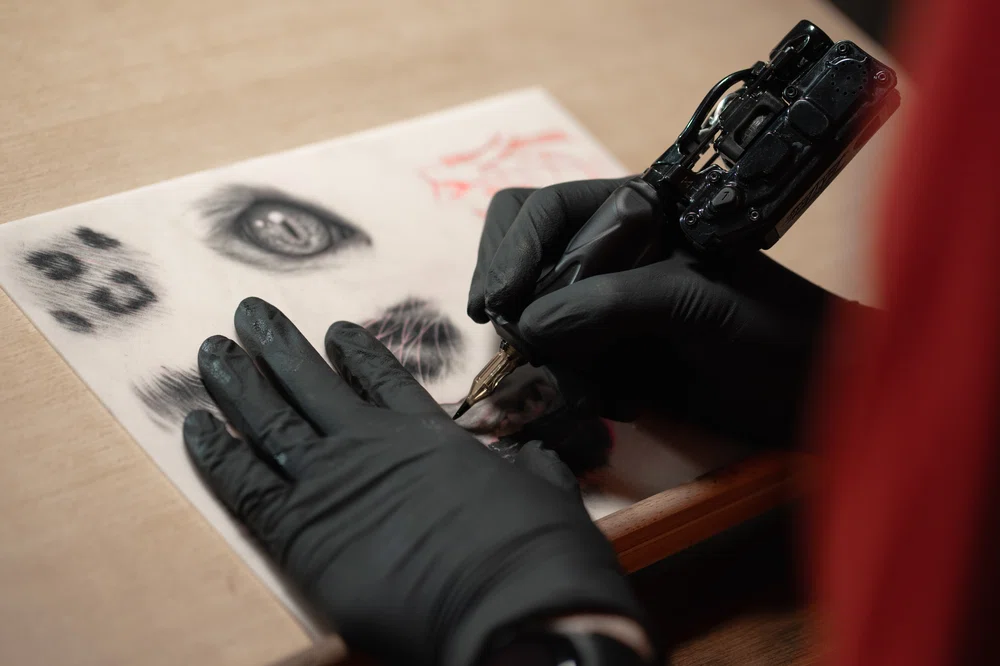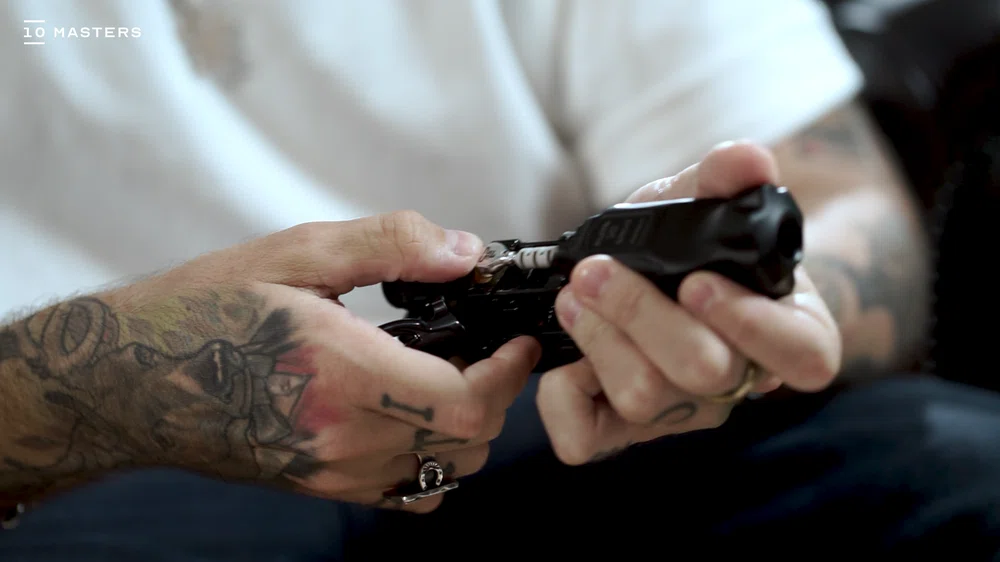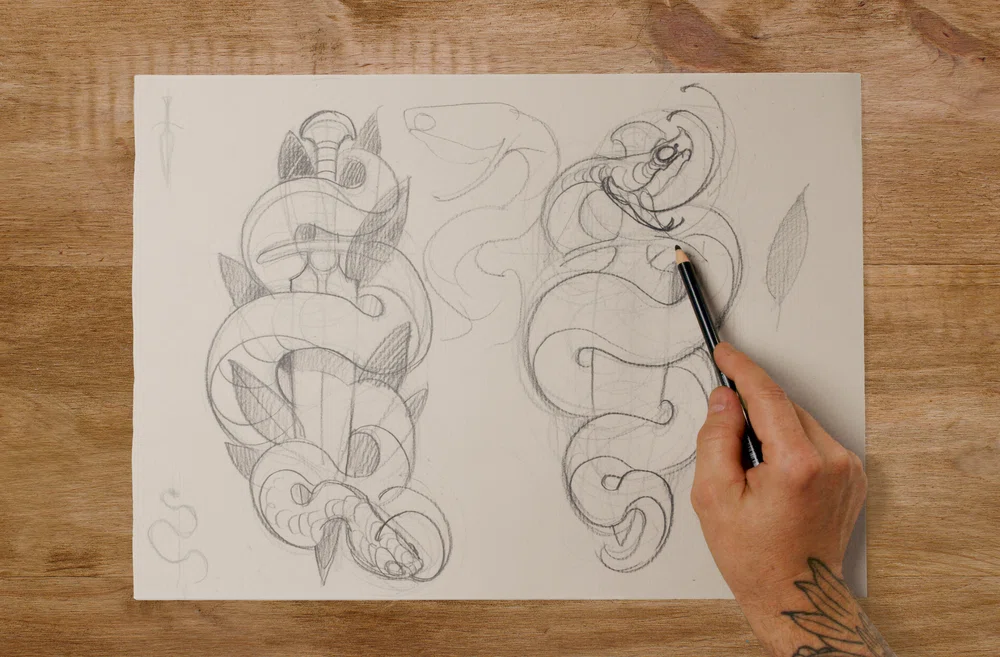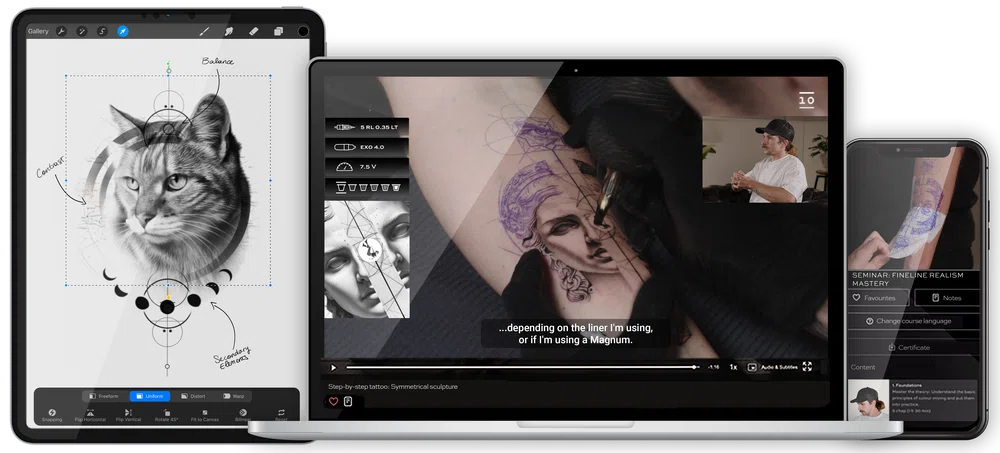If you Google "how to start tattooing," the first you see is course ads. The second, YouTube videos. You can’t help it—you click on one, and before you know it… you’re sucked into an endless vortex of content that does nothing but overwhelm you, make you panic, and run the hell away, never to look back.
Stop right there and listen:
You don’t need to know everything right now. Every skill takes time to learn, and there's no need to understand what the hell a Magnum is just yet. Patience, young Padawan—one step at a time.
What you do need is a mental roadmap of what learning to tattoo actually involves. And that’s exactly what you’re getting today.
If you’re here, chances are you have an artistic inclination or a deep interest in visual communication, and you see tattooing as a fascinating way to make a living from your creations.
If I’m right, and nothing excites you more than turning your designs into money, let me tell you—tattooing can be an incredibly rewarding career on many levels. But, just like any creative profession, it demands effort, time, and money.
So, if you’re serious about making a living from tattooing and you’re willing to put in the work, you’ve already got the most important part down. Next step? Mapping out the journey ahead.
There’s no one-size-fits-all path. There might be detours, a few technical stops, and tweaks depending on your goals. But in broad strokes, this is what it looks like…
In this article, you’ll discover:
- A step-by-step roadmap to start tattooing from scratch.
- The basic tattooing techniques every beginner should know.
- Tips for choosing your first tattoo machine.
- The key to becoming a standout professional in the tattoo industry.
Learning to tattoo from scratch
One crucial step in learning to tattoo is getting trained by experts in the field. Nothing better than the experience of someone who’s already walked that path! It’s always the most direct and reliable way to learn any skill, since it’s all about trial and error.
This is where you’ll get answers to what you’re probably wondering right now: What tattoo machine and needles should I buy? How do I tattoo a line, a shading, and a filling?
Another crucial step is getting hands-on and practicing like there’s no tomorrow.
Harsh truth: tattooing is learned by doing. Don’t wait until you feel “confident” to buy your first machine. Theory is important, of course, but it’s the practice that teaches you how to do it right.
To learn how to use your equipment and try out all those tricks you picked up in your training, practicing on synthetic skin is the way to go.
There are other surfaces to practice tattooing, like fruit or pig skin. They’re valid, and a lot of people still use them; but experience has shown us that synthetic skin is the best option today for several reasons. And while it’ll never be 100% like tattooing human skin, it’s super useful for learning.
Plus, this surface isn’t just for practicing all the basic tattoo techniques. It’s also for showing off what you can do as a tattoo artist.
Think you can’t start building a portfolio until you tattoo human skin? Think again.
All you need is social media to post your practice work and start showing the world your tattoo skills. And if the idea of putting yourself out there freaks you out just starting out, remember: nobody’s born knowing how to do this. Every tattoo artist you admire started just like you.
When it comes to becoming an expert at something, nobody gets out of having to try and fail. It’s part of the process.
In fact, at some point, you’ll need to make the leap from synthetic skin to human skin. And unless you’ve got a huge group of friends and family willing to volunteer their skin as guinea pigs, you’ll have to show publicly that you know how to tattoo—not just draw or design.
Starting to see things more clearly? Let’s take a look at the basic tattoo techniques you’ll need to learn.
You may also like:
Learn Different Tattoo Techniques

To master all the basic tattoo techniques, you first need to know them. They’ll be the foundation of your designs and the ones that’ll make your clients fall in love with your work.
Tattoos are basically made up of dots, lines, fillings, and shading. The ideal way is to learn each technique separately, starting with the simplest ones, then moving to the more complex. Once you’ve got them down, you can start mixing them however you like to create different contrasts, effects, volumes, and textures.
Now, let’s break down each technique…
- Linework: Lines are the skeleton of every tattoo, even in those where it’s barely noticeable—like in Realism, where the so-called water lines help shape the design but aren’t super obvious. You’d think linework is the easiest part, but watch out—it’s not as simple as it seems.
- Shading: The volume of a design comes from playing with light and shadow. If you already draw and are familiar with illustration concepts, congrats! you’re ahead of the game. But don’t get too cocky—drawing on paper is nothing like tattooing on skin. This technique is tricky to pull off, and there are a lot of factors at play.
- Dotwork: This is like shading’s chill cousin—it helps give your tattoos volume but in a more relaxed way. This technique doesn’t aim for super smooth and perfect transitions between shades; instead, it creates contrast and depth through textures and effects made from dots and lines. It’s a bit of a ‘safer’ way to shade, but heads up—it requires specific machine settings and hand movements to make it work.
- Filling: This one gets a little hate at the beginning. Remember how hard it was to color with markers and make everything even? Well, this is the same, but God Mode. Not only do you need to make sure the ink goes in evenly without wounding the skin, but also ensure it doesn’t end up looking patchy after healing. It’s tough, no lie, but with practice, you’ll get there.
- Color: The big sister of the filling technique. If you thought packing black ink was hard, color takes it to the next level. Here, the Color Theory applied to human skin comes into play. Many people consider this the hardest technique, but some even say they tattoo better in color than black. Either way, it’s fascinating, creative, and fun. If you come from a painting background and already have experience with color, you might absolutely love it.
As you can see, every basic technique has its pros and cons. Not super easy, but not impossible either. If they were, there wouldn’t be so many tattoo professionals in the world.
- Step one: Get to know them. You can cross that off the list ;).
- Step two: Master them. Let’s go for it!
- And step three? Choose which one you want to perfect to eventually develop your personal tattoo style and become a reference in the industry.
But remember—patience. Before we get into how you might become a tattoo legend, let’s go over the first thing you’ll need to practice these techniques…
You may also like:
- Advice for beginners: Tattooing Lines
- How to make shades in tattoos?
- Tattoo techniques: Dotwork
- How to Achieve Solid Fillings in a Tattoo
Learn to Use the Tattoo Machine

If you’re already thinking about learning to use the tattoo machine, you’ve probably already lost some sleep over the big question: Which tattoo machine should I choose as a beginner?
Yeah, I know, having so many options only makes it more confusing. But here’s a truth that (almost) no one tells you…
Your first machine won’t be the last, not even close. In fact, throughout your career, you might try way more machines than you expect—who knows, you might even get so into it that you become a collector.
The world of tattoo machines is so fascinating that some people dedicate their lives to understanding them and making others' life easier. Ever heard of "tattoo machine mechanics"? Yeah, just like motorcycle mechanics. Well, they exist, and let me tell you they’ll be your best allies if you decide to go for a coil machine.
Look, we could talk about tattoo machines all afternoon and I still couldn’t tell you which one you should buy. That’s something you’ll figure out based on your personal preferences, because it’ll depend on the style and techniques you want to use.
Don’t know what you want to tattoo or how? Then go for something versatile and easy to use; a mid-stroke machine that works for lines, shading, and filling; one that takes cartridge needles and doesn’t require constant maintenance or feel too heavy.
For example, Direct Drive and Gear System rotary machines, hybrids, and Pens are a good starting point. It doesn’t matter the brand—you don’t need the best one on the market. Just steer clear of the super cheap ones.
A compatible and stable power supply, and you’re good to go. You don’t need to know anything else for now. Time will come to learn everything about how to set it up and use it, so save that question about voltage for later.
What about needles? A whole different world, just as complex (if not more) than machines. Meanwhile, and to satisfy your curiosity, here’s an article for you: Types of Tattoo Needles.
Practice Drawing
Practicing drawing becomes super important when you want to stand out as a tattoo professional.
Is it possible to master all the techniques and make a living from tattooing without knowing how to draw? Sure, you could have a flawless technique and fill your schedule for months, but you’d face limitations when trying to specialize in a style, a few disadvantages when tattooing, and a harder time standing out from the competition.
If your goal is to level up as a tattoo professional and become recognized in the industry, it would be smart to develop your drawing skills. And the sooner, the better.
The good news is that it’s never too late to learn to draw—you can train it easily and it gives you a ton of advantages. Such is so that we even wrote about it: Benefits of knowing how to draw for tattooing.
If you were wondering how important is drawing in order to tattoo, that read will make everything crystal clear.
And above all—PRACTICE. Draw anything, scribble some lines, doodle whatever, it doesn’t mind what you do as long as you be friends with the pencil. Train your motor skills; that relationship is built only through habit.
Don’t know what to draw? Then check out the work of other tattoo artists, or even step outside the tattoo world—grab art books, go to a museum, read comics… there’s plenty of inspiration out there!
Remember: practice makes the master.
You may also like:

Get Trained as a Tattoo Artist
When it comes to choosing professional tattoo training, the first question that arises is: Where can I learn to tattoo?
The overwhelming number of options might leave you even more confused. But don’t worry, that’s normal, especially in a field like tattooing, where education doesn’t follow a conventional institutional structure.
This uncertainty in training might seem like a disadvantage, but it also has its perks.
Nowadays, you can learn to tattoo through various methods, and you don’t need any prior knowledge or a maximum number of study hours. However, there are some key regulations you need to be aware of to work legally as a tattooist.
These regulations vary from country to country, and even from region to region, so you’ll have to research what applies specifically to where you’re located. But just to give you an idea, here are the ones you’ll want to focus on for now:
- Health and Hygiene Certificate: This proves that you know how to keep everything clean, avoid infections, and handle materials safely for both you and your clients.
- Training Certificate: This shows you have the necessary techniques to tattoo and understand all the protocols to practice the craft.
It’s also important to keep in mind...
- Pigment Regulation: Some inks are regulated to ensure they don’t contain toxic substances. You’ll need to find out which products are approved in your country.
- Minimum Age Regulation: Generally, the legal minimum age is 18, although in some places it may be younger with parental or legal guardian consent.
- Labor Safety Regulations: Some areas also require you to follow occupational safety regulations, such as using proper personal protective equipment (gloves, masks, etc.) and implementing measures against ergonomic risks.
Education and Hands-on Learning
Now, how do you get the tattoo training certificate? Well, today you have the huge advantage that there are way more ways to learn to tattoo than before.
Being an apprentice in a studio isn’t your only option—there are also very comprehensive online courses that bring you close to the experience of having a mentor, without even having to leave your home.
I know what you’re thinking, and YES, you can learn to tattoo online, as long as you practice and apply everything you learn, of course.
The best part of this approach is that you can train with high-level artists, no matter where you are. Time isn’t a restriction either—you can learn at your own pace, repeat lessons as many times as you need, and even save tricks for later.
You can even watch raw and uncut full tattoo processes from different angles. Plus, you buy it once, and have it forever.
Does all that really exist? :O
In our training, sure do! And this is just the tip of the iceberg. Take a peek at our Professional Tattoo Courses.

Now, whether or not to invest in it, that’s up to you.
Let's be straight, getting into tattooing does require an initial investment, but here's a heads-up: the cost of starting on your own is much higher.
If you don’t start off on the right foot, not only will it take you longer to learn, but you’ll also pick up bad habits, won’t be sure you’re applying techniques properly, and won’t have the feedback you need to correct whatever you’re doing wrong.
In the end, you’ll be more prone to making mistakes and not even understand why, let alone how to avoid them. This can frustrate you, make you give up too soon, never want to touch a machine again, and make all your effort go to waste.
Without a doubt, guided training is the safest option for any aspiring or beginner tattoo artist.
Which path will you take?
Remember: You don’t have to be good to start. Start, and you will be ;).